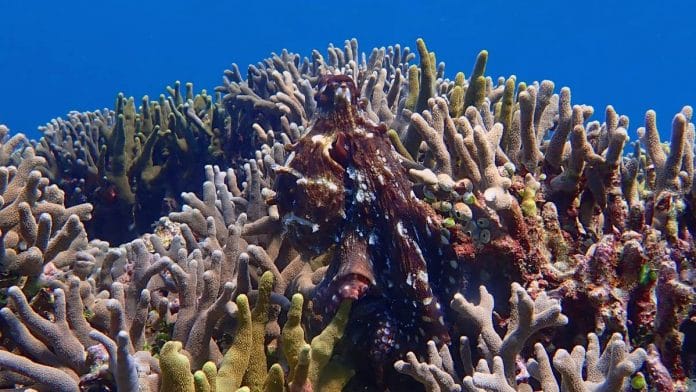New Delhi: Scientists have successfully recorded brain activity in freely moving octopuses by implanting electrodes and a data logger directly into the creatures, a first.
The study published in the journal Current Biology can help determine how octopus brains control their behaviour and could provide clues to the common principles needed for intelligence and cognition to occur.
According to the team of researchers from Okinawa Institute of Science and Technology (OIST), the octopus is the perfect animal to study in comparison to mammals. It has a large brain, a unique body, and advanced cognitive abilities that have developed completely different from those of vertebrates.
However, measuring the brainwaves of octopuses has proven a real technical challenge. Unlike vertebrates, octopuses are soft-bodied, so they have no skull on which recording equipment can be anchored.
Instead, the team used small and lightweight data loggers — originally designed to track the brain activity of birds during flight — and adapted the devices to make them waterproof. The batteries, which needed to work in a low-air environment, allowed up to 12 hours of continuous recording.
These loggers were surgically implanted in the octopus. The scientists then implanted the electrodes into an area of the octopus’s brain called the vertical lobe and median superior frontal lobe, which is the most accessible area.
The data helped scientists reveal several distinct brain activity patterns. Read more.
Also read: In Jupiter’s shadow, astronomers spot new aurorae shimmering in skies of its 4 largest moons
Magnetic ‘sixth sense’ in animals
Scientists have discovered a molecule present in all living cells that imparts a sense of magnetic sensitivity to a biological system, suggesting that the animal world’s ability to sense a magnetic field may be more widespread than previously thought.
The research by a team from the Universities of Manchester and Leicester, which was published in the journal Nature, improves our understanding of how animals sense and respond to magnetic fields in their environment.
This new knowledge could also enable the development of novel measurement tools where the activity of biological cells, including potentially those in humans, can be selectively stimulated using magnetic fields.
For the first time, the team shows that a molecule present in all living cells called flavin adenine dinucleotide (or FAD), can, in high enough amounts, impart magnetic sensitivity on a biological system.
Scientists already know that species such as the monarch butterfly, pigeon, turtle and other animals use the Earth’s magnetic field to navigate over long distances. But the discovery could mean the biological molecules required to sense magnetic fields are present — to a greater or lesser extent — in all living things.
The research team exploited the fruit fly (Drosophila melanogaster) to manipulate gene expression to test out their ideas. Read more.
Also Read: Neanderthals ate roasted crabs, reveal remains from paleolithic meals
Massive planet orbiting a star only 4 times its size discovered
Scientists have discovered an unusual planetary system in which a large gas giant planet orbits a small red dwarf star called TOI-5205, which challenges long-held ideas about planet formation.
The newly discovered planet, TOI 5205b, was first identified as a potential candidate by NASA’s Transiting Exoplanet Survey Satellite (TESS).
Researchers from Carnegie Institution for Science then confirmed its planetary nature and characterised it using a variety of ground-based instruments and facilities. The team’s research is published in The Astronomical Journal.
The host star, TOI-5205, is just about four times the size of Jupiter, yet it has managed to form a Jupiter-sized planet.
To grasp the size comparison, a Jupiter-like planet orbiting a Sun-like star could be compared to a pea going around a grapefruit.
For TOI-5205b, because the host star is much smaller, it is more like a pea going around a lemon. In fact, when the Jupiter-mass TOI 5205b crosses in front of its host, it blocks about seven per cent of its light— one of the largest known exoplanet transits.
A small number of gas giants have been discovered orbiting older M dwarf stars. But until now, no gas giant has been found in a planetary system around a low-mass M dwarf like TOI-5205. Read more.
New layer of Earth’s core discovered
Scientists at the Australian National University have discovered a new layer in the Earth — a distinct internal metallic ball embedded in the inner core like a petite Russian nesting doll.
To understand the Earth’s layers, it is important to understand the evolution of life on our planet’s surface. The inner core grows outwards by solidifying materials from the liquid outer core.
As these materials solidify, heat is released and causes upward movement in the liquid layer — known as a convection current. In turn, this convection generates our planet’s geomagnetic field, which protects us from cosmic radiation.
The researchers, according to their study published in Nature Communications, were able to make the discovery by studying seismic waves originating from powerful earthquakes travelling back and forth from one side of the globe to another.
It differs from previous studies because it uses seismic waves that bounce multiple times within Earth, along its diameter and through its centre. By capturing them, the team obtain an unparalleled sampling of the innermost inner core. Read more.
(Edited by Richa Mishra)
Also Read: Potential alien life to ocean on Saturn’s moon — here are this week’s scientific revelations






